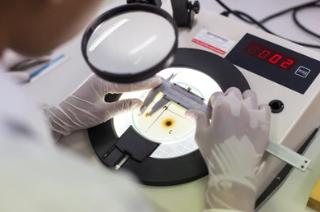Colony counting is used in different industries, including food and beverage tissues. The colony count is the total number of bacterial colonies grown in 1 g or 1 mL of the test sample after the food has been treated and incubated under certain conditions (such as aerobic conditions, nutritional conditions, pH, incubation temperature and time, etc.). According to the national standard method, that is, under aerobic conditions, 37°C culture for 48h can grow on the ordinary nutrient agar plate of the total number of bacterial colonies. Therefore, the total number of colonies does not indicate the actual total number of all bacteria, the total number of colonies does not distinguish the species of bacteria, so it is sometimes called the number of miscellaneous bacteria, aerobic bacteria, etc.

The total number of bacterial colonies, as a sign to determine the degree of contamination of food, is an indicative indicator of food hygiene, by testing the total number of colonies can predict the shelf life of food. The presence of microbial colonies will not only impact the quality of tea but also pose a threat to the health of the drinking population. Currently, European, American, and Japanese countries are constantly developing stricter and more extensive standards for colony counts in tea. So knowing your colony count helps ensure that the products you release don't end up hurting anyone and also helps ensure that your company is up to date on any compliance rules or regulations you need to follow.
One of the main reasons that colony counts are so important is that the microorganisms are so small that they are difficult to count directly. We aim to help our customers with this complex process. As a recognized leader in tea testing, Lifeasible can help you develop the best solution for rapid and non-destructive tea colony count testing.
Our labs have established clear and straightforward methods to detect total bacterial count in tea, including:
(1) Sampling. Take a certain amount of the sample to be tested with a sterile cotton ball, and then load it into a sterile petri dish.
(2) Sample preparation and dilution. Add an appropriate amount of medium to the Petri dish and stir well.
(3) Pouring plates.
(4) Coating plates.
(5) Inverted incubation. Place the sterilized culture dish in an environment of 25°C -30°C and incubate for 24-48h.
(6) Colony counting.
(7) Calculating colony counts.
Fast and accurate detection of colony counts in tea is of great importance for the health of the drinking population and foreign export trade. Our efficient, customer-focused service will guarantee the quality of your results and save you time and money. Our solutions ensure the best possible concentration for easy observation without affecting the results, improving the accuracy of colony tests for samples with special colors and fine particles. If you are interested in our solutions, please contact us for technical consultation and quotation.
Lifeasible has established a one-stop service platform for plants. In addition to obtaining customized solutions for plant genetic engineering, customers can also conduct follow-up analysis and research on plants through our analysis platform. The analytical services we provide include but are not limited to the following:
Get Latest Lifeasible News and Updates Directly to Your Inbox
Adaptive Evolutionary Mechanism of Plants
February 28, 2025
Unraveling Cotton Development: Insights from Multi-Omics Studies
February 27, 2025